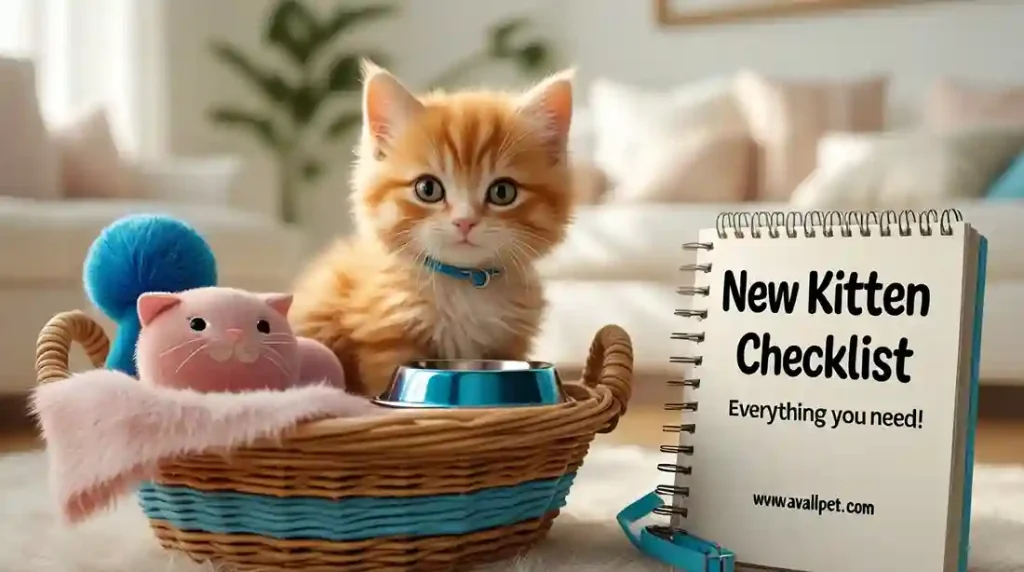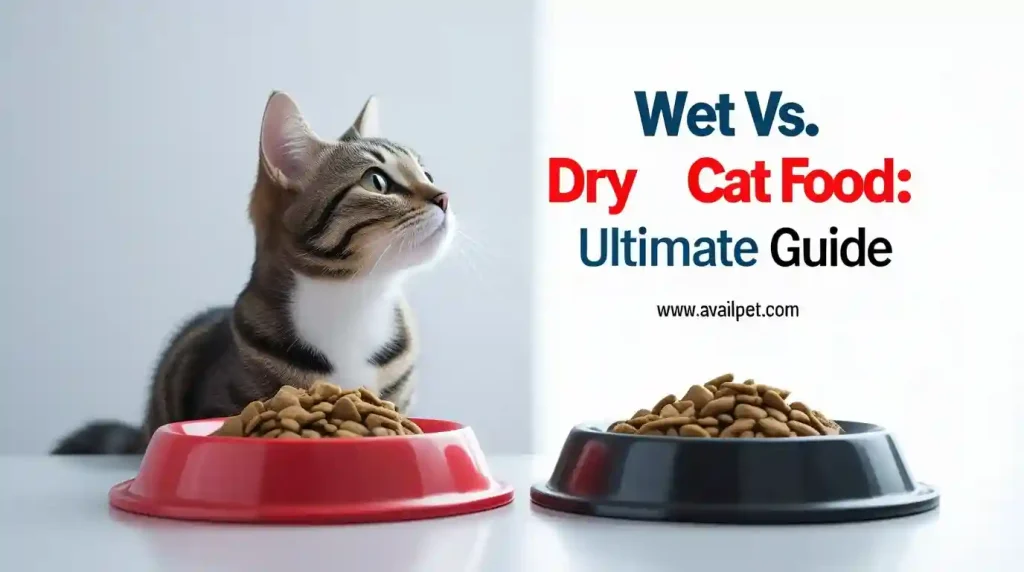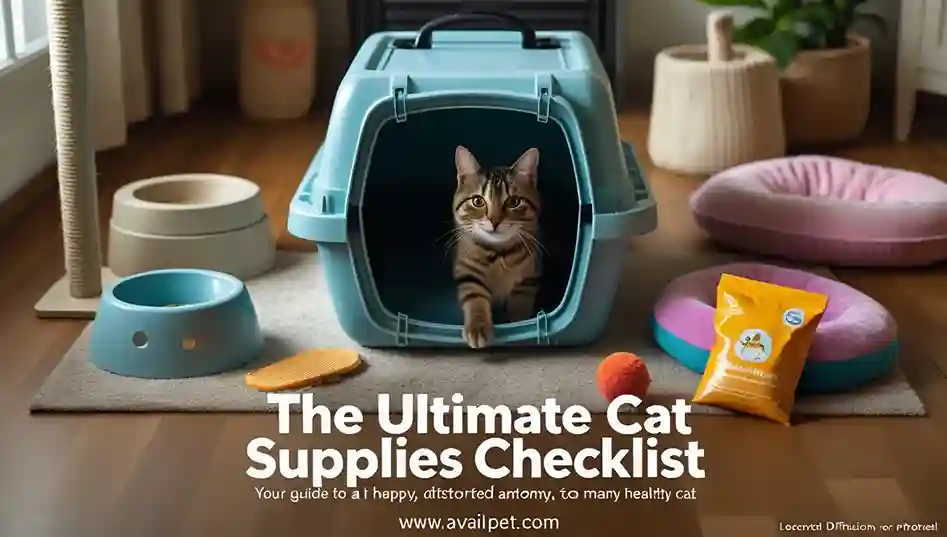Bringing a new kitten home is filled with joyful moments, but it also comes with a profound responsibility for their safety. Every choice you make, from their food to their toys, matters. And it all starts in one of the most important places in their new world: the litter box.
While you might be tempted to use any leftover litter you have on hand, the wrong choice can pose real risks to your tiny companion. Kittens are curious, they explore with their mouths, and their developing bodies are especially vulnerable. A litter that’s perfectly safe for an adult cat could be dangerous for a kitten.
At AvailPet, we believe a safe start is the only start. This vet-reviewed guide to the best cat litter for kittens cuts through the confusion. We focus exclusively on non-toxic, low-dust, and kitten-safe formulas, giving you the confidence to choose a litter that protects their health while making litter training a smooth and successful experience for you both.
Key Takeaways: Best Cat Litter for Kittens
Before we dive into the detailed reviews, here are the most critical insights from our veterinary consultation and safety testing:
- 🏆 Safest Overall: Fresh News Paper Litter is our top pick because it’s completely dust-free, soft on paws, and poses no risk of intestinal blockage if ingested.
- 👃 Best for Training: Dr. Elsey’s Kitten Attract uses a natural herb scent to guide kittens to the box, making litter training easier and more reliable.
- 🌫️ Best Low-Dust Clay: World’s Best Original Non-Clumping offers a familiar clay-like feel from corn, with minimal dust and no clumping dangers.
- ⚠️ Critical Safety Rule: Avoid all clumping litters for kittens under 4-6 months. Ingestion can cause life-threatening intestinal blockages.
- 💡 Pro Training Tip: Use a shallow litter box with just 1-2 inches of litter and place your kitten in it immediately after waking, eating, or playing.
Quick Comparison Table: Our Top Kitten-Safe Litters at a Glance
This table provides a snapshot of our top-rated, vet-approved litters for kittens. For in-depth reviews and safety insights, jump to the detailed reviews section.
| Product | Primary Material | Clumps? | Key Feature | Dust Level | Check Price |
|---|---|---|---|---|---|
| Fresh News Paper Litter | Recycled Paper | No | Safest if Ingested | Dust-Free | Check Amazon |
| Dr. Elsey’s Kitten Attract | Clay | No | Training Aid Scent | Low | Check Amazon |
| World’s Best Original Non-Clumping | Corn | No | Familiar, Low-Dust Feel | Low | Check Amazon |
| Ökocat Super Soft Kitten | Wood | No | Natural & Soft | Very Low | Check Amazon |
Why Kitten Litter is Different: The Critical Safety Rules
Choosing litter for a kitten isn’t the same as choosing for an adult cat. Their small size, developmental stage, and natural behaviors require specific safety considerations that must be your top priority.
1. The Ingestion Risk: Why We Say “No” to Clumping Litter
Kittens are naturally curious and explore the world with their mouths. It’s common for them to taste their litter. Clumping litter is strictly off-limits for kittens under 4-6 months old because if ingested, the litter can expand inside their tiny intestines, causing a life-threatening blockage. This is the single most important rule in kitten litter safety. For a detailed comparison of litter types, see our guide Clumping vs. Non-Clumping Cat Litter: What’s Better?.
2. Respiratory Health: The Danger of Dust
A kitten’s respiratory system is still developing, making it highly vulnerable to irritation. Dusty litters can trigger asthma-like symptoms, sneezing, and respiratory infections. Low-dust or completely dust-free litters are essential to protect their delicate lungs. This is why we prioritize low-dust options in our Best Natural Cat Litter guide for all life stages.
3. Paw Sensitivity: The Need for a Soft Landing
An adult cat’s paws are tough, but a kitten’s are soft and sensitive. Rough, sharp, or coarse litter can be uncomfortable to stand on, potentially discouraging them from using the box. A softer, finer-textured litter ensures a positive and comfortable experience from the start.
4. Avoiding Chemicals: The Case for Unscented
A kitten’s sense of smell is far more powerful than ours. Heavy perfumes and chemical deodorizers found in many scented litters can be overwhelming, deterring them from the box and potentially causing respiratory irritation. Unscented, natural litters are always the safest choice. For more tips on creating the perfect litter box setup, visit our comprehensive Cat Litter Guide.
Our Top Kitten Litter Picks: Vet-Reviewed Reviews
After thorough testing and veterinary consultation, these are our top recommendations for keeping your kitten safe and making litter training a success.
1. Fresh News Paper Litter — Safest Overall
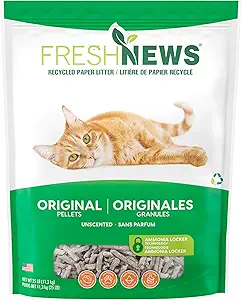
- Award: 🏆 Safest Overall.
- Key Specs: Material: Recycled Paper | Clumps: No | Dust Level: Dust-Free | Scent: Unscented.
Our In-Depth Analysis:
When absolute safety is the priority, Fresh News Paper Litter is our top choice. Its unique composition of recycled paper makes it the safest option on the market for curious kittens. Being completely dust-free, it protects your kitten’s developing respiratory system from any airborne irritants. The soft, highly absorbent pellets are gentle on sensitive paws and, most importantly, pose zero risk of intestinal blockage if ingested during exploration.
Pros:
- Extremely safe if accidentally ingested.
- 100% dust-free composition.
- Highly absorbent and soft on paws.
- Eco-friendly recycled material.
Cons:
- Doesn’t clump (requires more frequent full changes).
- Less effective on odor control than some other types.
- May need more frequent complete changes.
2. Dr. Elsey’s Kitten Attract — Best for Training
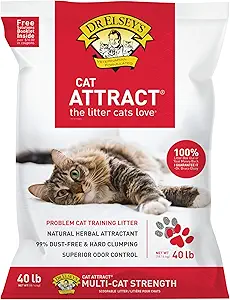
- Award: 👃 Best for Training.
- Key Specs: Material: Clay | Clumps: No | Dust Level: Low | Scent: Light Herbal.
Our In-Depth Analysis:
Dr. Elsey’s Kitten Attract is specifically formulated to make litter training easier and more reliable. The litter contains a natural herb scent that gently attracts kittens to the box, encouraging consistent use. As a non-clumping clay litter, it eliminates the danger of intestinal blockage while providing the familiar texture that many cats naturally prefer. The low-dust formula ensures a healthy environment for developing lungs.
Pros:
- Natural herb scent encourages litter box use.
- Non-clumping formula is safe for kittens.
- Familiar texture cats recognize easily.
- Low dust level.
Cons:
- Scented (though mild, may not suit all kittens).
- Requires more frequent stirring and changing.
- Not biodegradable.
3. World’s Best Original — Best Low-Dust & Familiar Feel
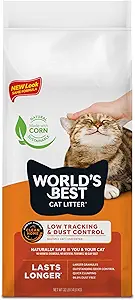
- Award: 🌫️ Best Low-Dust & Familiar Feel
- Key Specs: Material: Corn | Clumps: Quick| Dust Level: Low | Scent: Unscented
Our In-Depth Analysis:
For kitten parents seeking the familiar, sand-like texture of clay without the associated dust, World’s Best Original Non-Clumping is an outstanding choice. Made from whole-kernel corn, it provides a texture kittens instinctively understand, making the transition to a new home easier. It is naturally low-dust, protecting delicate respiratory systems, and its non-clumping formula eliminates the risk of intestinal blockage. It offers superior odor control through natural enzymes, not perfumes.
Pros:
- Familiar, fine texture encourages use.
- Non-clumping and safe for kittens.
- Naturally low dust.
- Excellent natural odor control.
Cons:
- Higher price point than standard clay.
- Lightweight granules can track easily.
- Some kittens may be sensitive to corn.
4. Ökocat Super Soft Kitten Litter — Best Natural
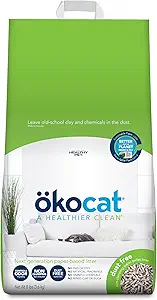
- Award: 🌿 Best Natural
- Key Specs: Material: Wood | Clumps: No | Dust Level: Very Low | Scent: Unscented
Our In-Depth Analysis:
Ökocat Super Soft offers a natural alternative that doesn’t compromise on safety. Made from reclaimed wood, this litter is exceptionally soft on delicate kitten paws while maintaining high absorbency. The very low dust level makes it ideal for respiratory health, and the natural wood fibers help control odors without chemicals. As a non-clumping formula, it’s completely safe if ingested during your kitten’s exploration phase.
Pros:
- Natural wood material, sustainably sourced.
- Very low dust and highly absorbent.
- Soft texture comfortable for paws.
- Good odor control without chemicals.
Cons:
- Wood pellet texture may be unfamiliar to some kittens.
- More expensive than clay alternatives.
- May track more than finer-textured litters.
Kitten Litter Buyer’s Guide: What to Look For
Choosing the right litter is one of the most important decisions you’ll make for your kitten’s health and hygiene. Use this checklist to ensure you’re making the safest choice.
1. Non-Clumping is Non-Negotiable
This is the most critical rule. Always choose a non-clumping litter for kittens under 4-6 months. Clumping litters pose a severe risk of life-threatening intestinal blockage if ingested, which is a common behavior in curious kittens. Stick with paper, wood pellets, or non-clumping clay until your kitten is older and has outgrown the habit of tasting everything. For a deeper understanding of the mechanics, see our guide: Clumping vs. Non-Clumping Cat Litter.
2. Prioritize Dust-Free or Ultra-Low Dust
A kitten’s respiratory system is fragile and still developing. Inhaling dust from litter can lead to sneezing, asthma-like symptoms, and respiratory infections. Look for litters explicitly labeled “dust-free” or “low-dust,” such as paper or processed wood litters, to ensure your kitten breathes easily.
3. Choose Unscented Formulas Every Time
A kitten’s sense of smell is far more sensitive than ours. The strong perfumes and chemicals in scented litters can be overwhelming, deter them from using the box, and potentially cause respiratory irritation. Unscented litters are always the safest and most reliable choice for encouraging consistent litter box use.
4. Opt for a Soft, Fine Texture
An adult cat’s paws are tough, but a kitten’s are soft and sensitive. Rough, coarse, or sharp litter can be uncomfortable to stand on. A softer, finer-textured litter (like fine paper pellets or sand-like non-clumping clay) ensures a comfortable experience that encourages good habits from the start.
5. Don’t Compromise on Absorbency
While safety comes first, performance still matters. A highly absorbent litter will control moisture better, making the box more comfortable and controlling ammonia odors. This is crucial for maintaining good hygiene and preventing your kitten from developing an aversion to a wet or smelly box. For more on maintaining a clean environment, visit our Cat Litter Guide.
How We Evaluated: Our Kitten-Safe Methodology
At AvailPet, we approach kitten product reviews with the highest level of scrutiny. Our recommendations are based on a specialized testing framework where safety is the non-negotiable priority, backed by veterinary expertise.
Our Kitten-Specific Safety Framework
We scored each litter on a 100-point scale, with heavy weighting on health and safety:
- Ingestion Safety (30 pts): The most critical factor. We consulted veterinary literature on intestinal blockages and gave top scores only to non-clumping, digestible-safe materials like paper.
- Dust Level & Respiratory Safety (25 pts): We measured airborne particulates during pouring and simulated digging, prioritizing litters that are virtually dust-free to protect developing lungs.
- Paw Texture & Comfort (20 pts): We assessed the softness and granule size to ensure the litter would be comfortable for sensitive kitten paws and not deter box use.
- Absorbency & Odor Control (15 pts): We evaluated how effectively the litter managed moisture and neutralized ammonia odors between cleanings.
- Value & Longevity (10 pts): We analyzed cost and how long the litter lasted before requiring a full change.
Beyond Testing: Our Commitment to Kitten Well-Being
Our process extends far beyond the physical product tests:
- Veterinary Partnership: Our selections and testing criteria were developed in consultation with a practicing DVM, with a specific focus on kitten ingestion risks, respiratory vulnerabilities, and safe material composition.
- Real-World User Analysis: We analyzed hundreds of verified customer reviews from kitten owners to identify patterns of successful training and any reported health concerns.
- Brand Transparency & Sourcing: We prioritized companies that provide clear information about their ingredients and manufacturing processes.
This rigorous, safety-first approach ensures that every litter we recommend has been vetted to provide the healthiest possible start for your new family member.
Kitten Litter Training & Transition Tips
Setting up your kitten for litter box success involves more than just choosing the right litter. Follow these vet-approved tips for a smooth training process and a safe transition to adult litter later on.
The Perfect Kitten Litter Box Setup
- Choose the Right Box: Use a shallow, low-sided box (no more than 3 inches high) that your kitten can easily step into. An old baking pan or a specially designed “kitten starter” box works perfectly.
- Location is Key: Place the box in a quiet, low-traffic area that’s easily accessible, but away from their food and water bowls. Avoid noisy appliances or sudden distractions.
- Start Simple: Only use 1-2 inches of litter. Too much depth can be intimidating and increase the chance of ingestion.
The Litter Training Process
- The First Introduction: Gently place your kitten in the box when you first bring them home, after they wake up from a nap, and about 20 minutes after they eat or drink.
- Positive Reinforcement: Never punish accidents. If you see your kitten using the box successfully, offer calm praise or a tiny treat.
- Accident Management: If you catch them in the act, calmly place them in the litter box. Clean any accidents outside the box thoroughly with an enzymatic cleaner to remove the scent completely.
Transitioning to Adult Litter: When and How
- The Right Time: You can consider switching to a clumping litter once your kitten is reliably not eating the litter and is between 4-6 months old. We recommend getting the all-clear from your vet during their spay/neuter checkup.
- The Slow Switch Method: A gradual transition over 7-10 days is crucial to prevent aversion.
- Days 1-3: 75% old kitten litter, 25% new adult litter.
- Days 4-6: 50% old kitten litter, 50% new adult litter.
- Days 7-10: 25% old kitten litter, 75% new adult litter.
- Monitor Closely: Watch for any signs of avoidance or a return to tasting the litter. If this happens, revert to a previous mixture for a few more days. For more on choosing an adult litter, see our guide to the Best Clumping Cat Litter.
FAQs About Best Cat Litter for Kittens
When can kittens use clumping litter?
Kittens can typically transition to clumping litter around 4-6 months of age. The key is to wait until they are reliably not eating the litter and are large enough that the risk of a life-threatening intestinal blockage from accidental ingestion is significantly reduced. We recommend consulting your veterinarian for final approval during their spay/neuter checkup. For safe options in the meantime, see our Best Natural Cat Litter guide.
How often should I change a kitten’s litter?
Kittens have small bladders and may use the box more frequently. For non-clumping litter, scoop solid waste at least twice daily and do a full litter change every 2-3 days. For clumping litter (once they’re old enough), scoop waste daily and change the entire box every 2-4 weeks. Always change immediately if the litter becomes wet or soiled.
What should I do if my kitten eats litter?
Contact your veterinarian immediately. While non-clumping paper or wood litters are less dangerous, any ingested litter can cause digestive issues or blockages. Your vet can advise you on warning signs to watch for, such as lethargy, vomiting, or loss of appetite. Prevent future access by using a covered box or switching to a safer litter type.
Why is my kitten avoiding the litter box?
Several common issues can cause this:
- The box is too intimidating (too deep, too high-sided, or too dirty).
- The litter texture is uncomfortable on their paws.
- The location is too noisy or busy.
A medical issue, like a urinary tract infection, is causing pain.
Address these factors first. If the problem persists, a vet visit is crucial to rule out health problems.
Conclusion: A Safe Start for Your Kitten
Choosing the right litter is one of the most impactful decisions you can make for your kitten’s health and well-being. By prioritizing safety above all else, you’re not just preventing immediate risks—you’re also establishing the foundation for a lifetime of good litter box habits.
Your safest path forward depends on your current needs:
- For absolute peace of mind and zero risk, Fresh News Paper Litter remains the gold standard for new kittens.
- If you’re starting the training process, Dr. Elsey’s Kitten Attract provides that extra guidance to help your kitten succeed.
- When it’s finally time to transition to adult litter, remember to make the switch gradually over 7-10 days and choose a high-quality, low-dust clumping litter.
Your kitten’s health and safety are worth every careful consideration. We encourage you to use the links in our reviews to find the right kitten-safe litter and start this important journey with confidence. Here’s to happy, healthy growth and many years of wonderful companionship ahead!
Sources
- VCA Hospitals – Kitten Care
- Cornell Feline Health Center – Kitten Care
- ASPCA – Kitten Proofing Your Home
- Fresh News Paper Litter
- Dr. Elsey’s Kitten Attract
- Frisco Non-Clumping Litter
- Ökocat Kitten Litter
Disclaimer: Our recommendations are based on independent research, safety testing, and veterinary guidance. Product information and pricing are subject to change. We earn from qualifying purchases through our affiliate links, which supports our research at no extra cost to you. We are not veterinarians; this information is for educational purposes only. Always consult your veterinarian for advice on your kitten’s specific health and dietary needs.

